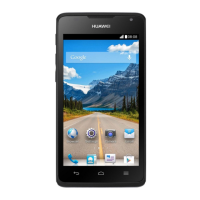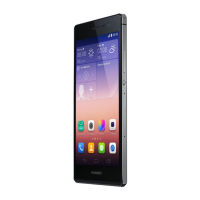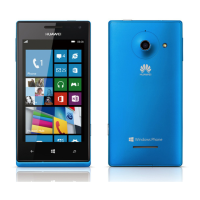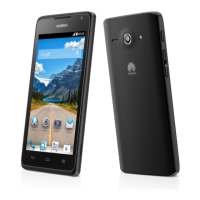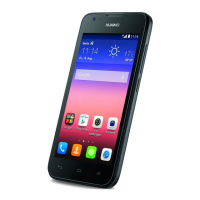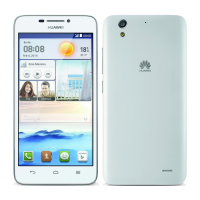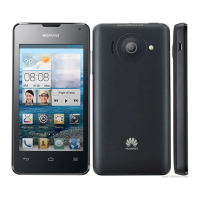Do you have a question about the Huawei ASCEND M860 and is the answer not in the manual?
Safety guidelines for the correct and safe use of the mobile phone.
Copyright, trademarks, and warranty information for the user guide.
Overview of the mobile phone's physical components, buttons, and basic functions.
Step-by-step guide for installing the battery and charging the device.
Instructions on powering the phone on/off and using touchscreen gestures.
Methods to secure the phone by locking and unlocking the screen.
Description of the home screen layout, icons, and notification panel.
Instructions for inserting and using a microSD card for storage.
Steps to initiate calls using the dialer, contacts, or call log.
How to place a call by selecting a contact from the phone's contact list.
Procedures for answering or declining incoming phone calls.
Managing conference calls, switching between calls, and using headset functions.
Viewing call history and enabling airplane mode for wireless connections.
Using the phone with a Teletypewriter (TTY) device for text communication.
Adjusting phone settings to ensure compatibility with hearing aids.
Accessing the contacts application and creating new contact entries.
Modifying existing contact details such as name, phone number, and email.
Ways to call or message contacts directly from the contacts list.
Procedure for removing a contact entry from the phone.
Creating and editing contact groups for organized communication.
Methods to open and hide the onscreen keyboard.
Adjusting keyboard layout and input methods for personalized use.
Details on text and multimedia message limits, features, and sending.
Configuring and using the email application for sending and receiving emails.
Enabling mobile data and connecting to wireless networks for internet access.
Using the mobile phone's web browser to access the internet and manage bookmarks.
Pairing, connecting, and transferring files using Bluetooth technology.
Guide to using the camera for capturing photos and recording videos.
Viewing, editing, and organizing photos and videos stored on the phone.
Copying music to the phone and playing music files.
Creating a Google account and using the Gmail application for email.
Using Google Talk for instant messaging and chat.
Navigating with Google Maps, finding places, and getting directions.
Viewing videos on YouTube and downloading apps from Android Market.
Adding, removing, and configuring accounts for data synchronization.
Configuring sync options for background data and specific accounts.
Creating and managing events, meetings, and appointments in the calendar.
Setting, customizing, and managing alarms on the mobile phone.
Recording voice clips and organizing/managing files and folders.
Performing calculations and creating text notes using built-in applications.
Adjusting the phone's date, time, and time zone settings.
Adjusting screen brightness and timeout settings for optimal viewing.
Customizing ringtone volume, silent mode, and phone vibration for calls.
Customizing call settings, data roaming, and mobile data services.
Securing the phone with a screen lock and managing installed applications.
Backing up settings, restoring factory defaults, and updating the phone's software.
Safety information regarding electronic devices, medical devices, and explosive atmospheres.
Safety guidelines for the correct and safe use of the mobile phone.
Copyright, trademarks, and warranty information for the user guide.
Overview of the mobile phone's physical components, buttons, and basic functions.
Step-by-step guide for installing the battery and charging the device.
Instructions on powering the phone on/off and using touchscreen gestures.
Methods to secure the phone by locking and unlocking the screen.
Description of the home screen layout, icons, and notification panel.
Instructions for inserting and using a microSD card for storage.
Steps to initiate calls using the dialer, contacts, or call log.
How to place a call by selecting a contact from the phone's contact list.
Procedures for answering or declining incoming phone calls.
Managing conference calls, switching between calls, and using headset functions.
Viewing call history and enabling airplane mode for wireless connections.
Using the phone with a Teletypewriter (TTY) device for text communication.
Adjusting phone settings to ensure compatibility with hearing aids.
Accessing the contacts application and creating new contact entries.
Modifying existing contact details such as name, phone number, and email.
Ways to call or message contacts directly from the contacts list.
Procedure for removing a contact entry from the phone.
Creating and editing contact groups for organized communication.
Methods to open and hide the onscreen keyboard.
Adjusting keyboard layout and input methods for personalized use.
Details on text and multimedia message limits, features, and sending.
Configuring and using the email application for sending and receiving emails.
Enabling mobile data and connecting to wireless networks for internet access.
Using the mobile phone's web browser to access the internet and manage bookmarks.
Pairing, connecting, and transferring files using Bluetooth technology.
Guide to using the camera for capturing photos and recording videos.
Viewing, editing, and organizing photos and videos stored on the phone.
Copying music to the phone and playing music files.
Creating a Google account and using the Gmail application for email.
Using Google Talk for instant messaging and chat.
Navigating with Google Maps, finding places, and getting directions.
Viewing videos on YouTube and downloading apps from Android Market.
Adding, removing, and configuring accounts for data synchronization.
Configuring sync options for background data and specific accounts.
Creating and managing events, meetings, and appointments in the calendar.
Setting, customizing, and managing alarms on the mobile phone.
Recording voice clips and organizing/managing files and folders.
Performing calculations and creating text notes using built-in applications.
Adjusting the phone's date, time, and time zone settings.
Adjusting screen brightness and timeout settings for optimal viewing.
Customizing ringtone volume, silent mode, and phone vibration for calls.
Customizing call settings, data roaming, and mobile data services.
Securing the phone with a screen lock and managing installed applications.
Backing up settings, restoring factory defaults, and updating the phone's software.
Safety information regarding electronic devices, medical devices, and explosive atmospheres.
| GPRS | No |
|---|---|
| EDGE | No |
| Weight | 130 g (4.59 oz) |
| SIM | Mini-SIM |
| OS | Android OS, v2.1 (Eclair) |
| Chipset | Qualcomm MSM7627 |
| CPU | 528 MHz ARM 11 |
| GPU | Adreno 200 |
| Memory Card slot | microSD, up to 32 GB |
| Internal | 256 MB RAM, 512 MB ROM |
| Primary Camera | 3.15 MP |
| Video | Yes |
| Secondary Camera | No |
| Alert types | Vibration; MP3, WAV ringtones |
| Loudspeaker | Yes |
| 3.5mm jack | Yes |
| WLAN | Wi-Fi 802.11 b/g |
| Bluetooth | v2.1, A2DP |
| GPS | Yes, with A-GPS |
| Radio | No |
| USB | microUSB v2.0 |
| Browser | HTML |
| Java | Yes, via Java MIDP emulator |
| Battery | Li-Ion 1500 mAh battery |
| Colors | Black |
| Network | CDMA |
| Type | TFT touchscreen |
| Size | 3.2 inches |
| Messaging | SMS, MMS, Email |



